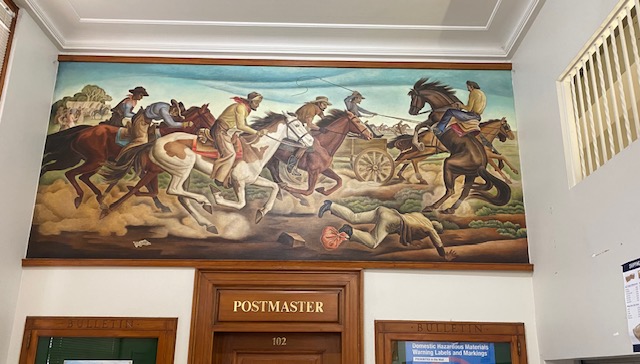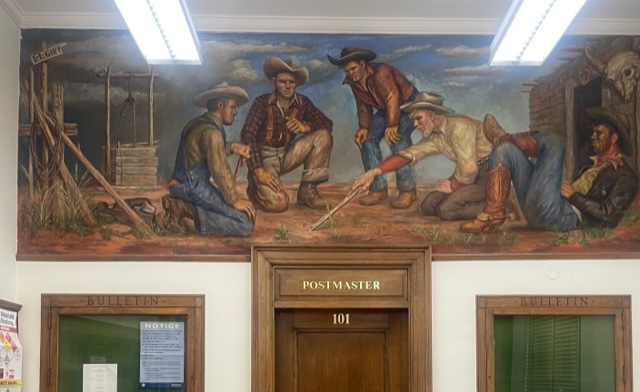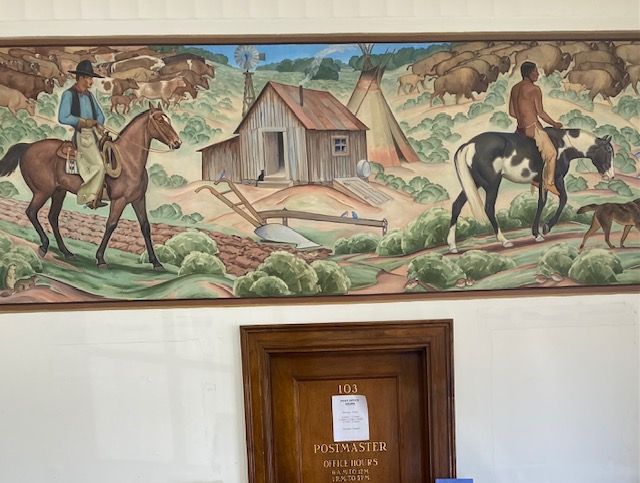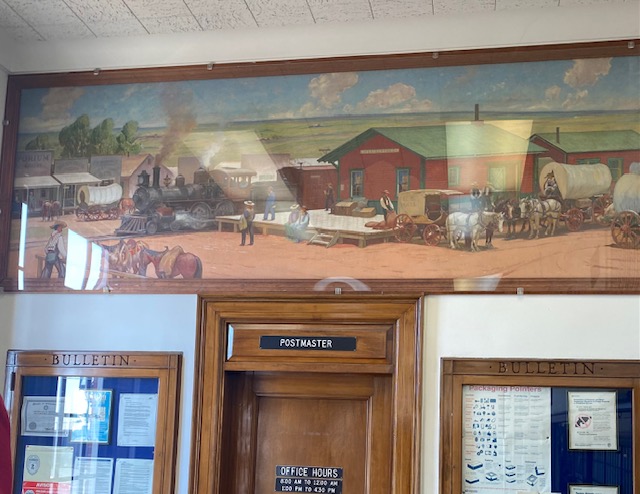If we pay attention, vestiges of the Great Depression surround us. Called “the worst hard time,” the decade of the 1930s saw the national unemployment rate soar to twenty-five percent, and those fortunate enough to have jobs experienced plummeting incomes. It was during this era of national uncertainty and suffering that Franklin Delano Roosevelt became the 32nd President of the United States. Perhaps what Roosevelt is best known for is his approach to alleviating the ailing economy. His huge labyrinth of public assistance programs became known as the New Deal and offered a lifeline to millions of desperate citizens. Some of the best known work-relief programs were the Works Progress Administration (WPA) and the Civilian Conservation Corps (CCC). Here in western Oklahoma, many of the products of those two programs still exist and are used even today. For instance, in Elk City, the Ackley Park ballfield was constructed by the WPA, and baseball teams still play there. In Mangum, the WPA built the National Guard Armory, and while the Oklahoma National Guard no longer uses the building, it has been repurposed and continues to be viable. Quartz Mountain State Park owes its existence to both the WPA and the CCC. The WPA readied the construction site for the dam that created Altus-Lugert Lake, and the CCC built hiking trails, picnic areas, and boat ramps. When we swim or boat in the lake or picnic at Quartz Mountain, we benefit from the labor of the WPA and CCC workers and the foresight of FDR.
A lesser-known program of the New Deal employed artists, and the works of those government-employed painters still grace the walls of government buildings. Administered by the U. S. Treasury Department, the program was known as the Section of Painting and Sculpture. The Great Depression became known for the plight of the “common man.” Roosevelt observed, “Always the heart and soul of our country will be the heart and soul of the common man.” To that end, the President sought to bring hope and pride to the masses through murals installed on Post Office walls and other government facilities.
Unlike the WPA and the CCC, the Section of Painting and Sculpture did not always seek to employ the destitute. Artists were chosen for their abilities through competitions. Some well-known artists chose not to apply, thinking that their art and reputations could stand on their own merits without the government’s help, but for those who chose to complete, the process was rigorous. It was also anonymous, which gave everyone an equal chance. As a result, the pool of finalists included women and Black and Native American artists.
The 48 States Competition was the first contest held to choose artists for the Post Office murals. The purpose was to give a mural to a Post Office in each state. The first step in the process required that the artist submit a black and white sketch followed by a colored sketch painted to scale. To keep the competition anonymous, the artist attached a sealed envelope containing his/her name and address to the back of the sketch. If the artist made it through this stage, he/she submitted a photo of a cartoon of his/her proposed mural. After the announcement of the winners, Life magazine published an article about the competition with postage-stamp sized photos of the winning paintings in the December 1939 issue.
The Purcell, Oklahoma Post Office became the recipient of the state’s winner of the 48 States Competition; however, the mural destined for the space above the Postmaster’s door in Purcell was not without controversy. Artist Fred Conway originally submitted a mural entitled “The Roundup” to the Jackson, Missouri Post Office. The people of Jackson wanted something more modern and subsequently rejected the painting based on the theme. So the 48 States Competition jury sent “The Roundup,” depicting cowboys rounding up cattle, to Purcell where it remains today.
The 48 States Competition spawned more competitions for even more Post Office murals, mostly in metropolitan areas. Runners-up in those competitions usually earned a spot in smaller rural Post Offices. In all, Oklahoma towns received 32 Post Office murals. Five have been moved and one destroyed, but the majority of them still hang in the Post Offices over the door to the Postmaster’s office.
The artists were encouraged to visit the communities where their work would reside, but travel being difficult during the Depression, many relied on correspondence with community leaders. The paintings were meant to reflect the history or the general feel of the town. The Treasury Department allowed somewhere in the neighborhood of $500 to $750 for each mural. Out of that amount, the artist had to buy supplies and install the mural. The rest was paid to the artist in increments.
Some of the towns in western Oklahoma that have Post Office murals are Sayre, Hollis, Cordell, and Weatherford. The Sayre mural was completed in 1940 to adorn a wall of the newly constructed Post Office. Entitled “The Opening of the Cheyenne and Arapaho Country,” it depicts pioneers racing for land with one unfortunate man, having fallen, lying face down on the ground. Some are surprised that Beckham County was part of a land run, but on April 19, 1893, twenty-five thousand people raced for 160 acres of free land in what had been the Cheyenne-Arapaho Reservation. Six new counties were formed, including Roger Mills County. At statehood in 1907, Beckham County was created from northern Greer County and southern Roger Mills County.
Vance Kirkland, the artist chosen to paint the Sayre mural, came from the competition held in Amarillo, Texas. He lived in Colorado and was already an artist of some renown. In fact, the Kirkland Museum still exists in Denver and exhibits Vance Kirkland’s art along with other exhibitions.

Lloyd Lozes Goff, who painted the Hollis mural, came from the San Antonio competition. In 1941 when he painted the mural, he was an art student at the University of New Mexico. The mural is entitled “Mapping the Trail” and features a group of cowboys planning the route for a cattle drive. One cowboy is drawing the route in the dirt. Goff used people that he knew to depict the old-time cattle drivers.

Completed in 1938, the Cordell Post Office mural is entitled “The Scene Changes.” Artist Ila McAfee Turner of Taos, New Mexico, painted the mural to depict the change from Native American culture to the culture brought by the newly-arrived white settlers. Turner, an established artist, painted several other Post Office murals including one in Edmond, Oklahoma. She specialized in murals, and she restored the Cordell painting in 1968.

The Weatherford Post Office mural was painted by award-winning artist Oscar E. Berninghaus. Entitled “Terminus of the Railroad, 1898-1901” the painting is a rendition of Weatherford at the turn of the century. Weatherford was a shipping hub where goods were brought by railroad and shipped by other conveyances to different parts of the territory. Berninghaus completed the mural in 1940. He went on to paint two more murals for the Post Office in Phoenix, Arizona. A native of St. Louis, Missouri, Berninghaus won several awards and had paintings displayed in many prestigious museums.

Some of the existing Post Office murals are showing signs of age, and florescent lights near them give off a glare that obscures the view. However, the paintings give us a glimpse into the past. Historical in subject matter, they represent a style of painting not often done today. They also depict the paradox of a time in our state when life was both simple and desperate. When we mail a letter, attend a baseball game, or visit a state park, if we take time to notice and reflect, we can almost feel the ghosts of the Great Depression all around us.
Sources
Calcagno, Nicholas A. New Deal Murals in Oklahoma. Oklahoma Humanities Committee, 1976.
“The 48 States Competition (1939).” wpamurals.org. Nancy Lorance. 2006. 12 Apr. 2023. http://wpamurals.org/48states.htm
Kennedy, Roger G. and David Larkin. When Art Worked: The New Deal, Art, and Democracy. New York: Rizzoli International Publications, Inc., 2009.
Marling, Karal Ann. Wall to Wall America: Post Office Murals in the Great Depression. Minneapolis: University of Minnesota Press, 1982.
“Post Office Murals.” University of Central Arkansas. 2023. 12 Apr. 2023. https://uca.edu/postofficemurals/
“Post Office New Deal Artwork.” New Deal/WPA Art in Oklahoma. 2006. Nancy Lorance. 25 Apr. 2026. http://wpamurals.org/oklahoma.htm.
““Purcell, Oklahoma Post Office Mural.” Texas Escapes Online Magazine. n.d. 6 Apr. 2023. http://www.texasescapes.com/Art/Oklahoma-Purcell-POMural-TheRoundup-FrederickConway.htm
Reggio, Michael H. “Cheyenne-Arapaho Opening.” The Encyclopedia of Oklahoma History and Culture. Oklahoma Historical Society. n.d. 13 Apr. 2023. https://okhistory.org/publications/enc/entry?entry=CH031
Soelle, Sally Bradstreet. “Post Office Murals.” The Encyclopedia of Oklahoma History and Culture. Oklahoma Historical Society. n.d. 20 Apr. 2023. https://www.okhistory.org/publications/enc/entry?entry=PO021